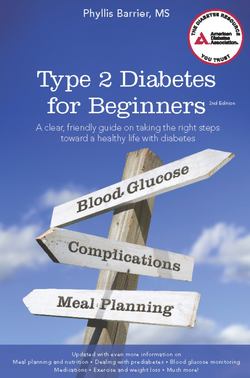Читать книгу Type 2 Diabetes for Beginners - Phyllis Barrier - Страница 4
На сайте Литреса книга снята с продажи.
Оглавление—1—
What Is Prediabetes?
Prediabetes is a condition that comes before type 2 diabetes. It means that blood glucose (GLOO-kos) levels are higher than normal but aren’t high enough to be called diabetes. As we become older, or less active, or gain weight, we are more at risk for prediabetes and type 2 diabetes. People can have prediabetes and not know it.
If you have prediabetes, it means:
• you might get type 2 diabetes sometime soon or further down the road.
• you are more likely to get heart disease or have a stroke.
The good news is that you can take steps to delay or prevent type 2 diabetes with:
• weight loss
• regular physical activity, such as walking almost every day
A study called the Diabetes Prevention Program showed that these steps helped most people delay or prevent type 2 diabetes. Losing weight and being active worked well for people of all ages.
Weight loss can delay or prevent type 2 diabetes. Reaching a healthy weight can help you a lot. If you’re overweight, any weight loss, even 10 or 15 pounds, will lower your chances of getting type 2 diabetes.
Losing extra weight helped people in the Diabetes Prevention Program delay or prevent type 2 diabetes. People in the study lost an average of 15 pounds in the first year of the study. How did they do it? They ate fewer calories and less fat. And they exercised most days of the week. In fact, many walked about 150 minutes a week.
Being active almost every day is another one of the best ways to delay or prevent type 2 diabetes. You can lower your chances of getting type 2 diabetes by adding physical activity to your daily routine. Even if you have heart disease or other problems, you can still be more active. Work with your health care team to find out which physical activities are safe for you.
As we all know, losing weight and getting active can be hard. And sticking with it can be even harder. The American Diabetes Association suggests an ongoing support group and counseling to help. Diabetes medicines may be added if you’re at high risk for getting type 2.
It helps to keep track of the progress you’re making with eating and walking. Write down everything you eat and drink for a week. Writing things down makes you more aware of what you’re eating and helps with weight loss. You can keep track of your walking by wearing a pedometer on your belt. A pedometer is a small device that tells you how many steps you’ve taken. Or you can keep track of your walking or other activity by writing it down for a week. At the end of the week, total up the minutes you’ve been active to see how you’re doing.
If you have prediabetes, you may suspect that someone you love has prediabetes or type 2 diabetes. At their next doctor visit, ask them to get their blood glucose checked if they are:
• 45 or older
• Under 45, but overweight and have one or more of these risk factors:
♦ They have a close family member, like a parent, brother, or sister, with diabetes.
♦ They are:
◊ African American
◊ Native American
◊ Asian American
◊ Pacific Islander
◊ Hispanic American (Latino)
♦ They’ve had a baby weighing more than nine pounds or they’ve had gestational (jess-TAY-shuhn-uhl) diabetes. Gestational diabetes is diabetes first found during pregnancy that is not type 1 or type 2.
♦ They have high blood pressure (over 140/90) or are taking a blood pressure medication.
♦ They have low HDL cholesterol, the good cholesterol (35 or lower).
♦ They have high triglycerides (250 or higher).
Small steps lead to big rewards. Taking small steps to change the way you eat and increase your activity can delay or prevent type 2 diabetes. Decide how you’ll reduce your calories to lose weight. Think about what you’re willing and able to do to be more active almost every day.
Type 2 diabetes is a serious disease. If you delay or prevent it, you’ll enjoy better health in the long run. Feeling good and having energy are keys to living the good life.
